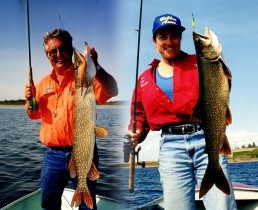Catch and Release: Does it Work?
SHARE THIS POST
Dan Gapen provides strong evidence that when fish are caught and released they survive.
More years ago than I can remember, I had an incident on a crystal clear lake in the north. I was guiding a couple of gentlemen from Chicago. The man on the bow seat of the boat hooked and I landed a decent-sized northern pike. I hand-landed it and then released it. The weight was about 12 pounds. Once released, the pike slid ahead of us and settled on the bottom next to the patch of weeds it had originally come out of.
One crazy pike
As the man who had caught him re-cast, I was surprised to see the fish move up off the bottom and take a beeline after the same bait he had originally been caught on. Once again, the pike was landed and released. This time, upon releasing it, the pike swam about three feet into the bottom foliage and held 6 feet off the bottom, finning gently to keep itself in place.
As the second angler drew his spoon over it on his next cast, the released pike rose up and engaged the spoon. This time he wasn’t hooked but instead settled down deeper into the foliage. This fish had to be nuts or extremely hungry.
The final hook-up came when the bow man ran his Eppinger over the weed bed once again. You guessed it—this fish engaged the spoon again. Of course his fight was short, but remained fairly strong. This time on release, he headed far back in the weeds and disappeared out of sight.
All three of us were shocked at the pike’s performance. A white piece of skin dangled from his lower jaw, making this fish easily identifiable. Both my guests were dumfounded that he’d struck the spoon five times!
Are you enjoying this post?
You can be among the first to get the latest info on where to go, what to use and how to use it!
Six hours later, I suggested we work that same weed bed. I wanted to see if that foolish pike might strike. Previous trips in the location provided 20-plus trophy fish. Wouldn’t you know, on the same spoon, the pike with the white, scarred lip struck and was landed and released. This pike had been caught six times in one day on a similar spoon.
Catch-recidivism is common
From that point on, I kind of watched out for the releasing of my caught pike and found that such an experience is not uncommon. To better validate the catch-and-release theory, ‘Bobber’ Anne, Ray Dupuis, and I were on the overflow that runs out of Lake Nipigon, filming trophy brook trout. This time, we had the underwater camera running. Anne had taken a 3-pound brookie. On release, we followed its run back out to a granite lip it had come off of. She had been using a number 6 Muddler fly.
Once it settled in behind the lip we presumed she’d come from, I kept the camera running to obtain footage of brook trout on structure. Minutes later, my buddy Ray cast a similar Muddler fly over her and she struck it again. This time when released it swam downstream and headed across the river.
Put ‘em back to bite again.
During that day at the overflow, we caught 19 trout with scarred lips, proof that catch and release works on brook trout. I take numerous bass and walleyes with hook scars proving they’d been caught before. Does it work on all species? I am not sure! However, readers of MidWest Outdoors may be assured that a species you encounter locally, if released, will swim away to bite again.
Want more fishing insights? Find them in the February issue of MidWest Outdoors, available the first full week of February at the newsstand or by subscribing on our website.
MWO
SHARE THIS POST
You may also like...
Nothing found.
Did you enjoy this post?
You can be among the first to get the latest info on where to go, what to use and how to use it!
Dan Gapen
Considered one of the world’s leading river anglers, Dan Gapen, Sr. has shared his knowledge with MidWest Outdoors readers and viewers for more than 40 years. He is a member of all three Fishing Halls of Fame—International, National Freshwater, and Minnesota. He has an immense grasp of the world’s fisheries. He may be contacted at 877-623-2099.
@TheGapenCompany.
